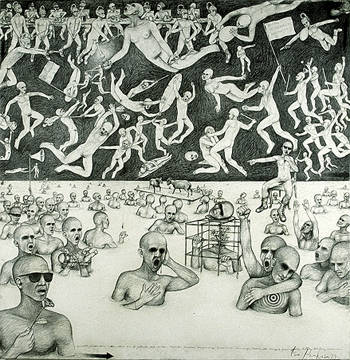
|
"Feast
of Democracy" Pencil on primed canvas, 1999 57" x 56"
|
|
Isa was born in northwestern Java in 1964, fourth of nine children. "I was always the different one," he says, "always the crazy one, with the long hair, wanting to be an artist." His talent wasn't a surprise since his father was a traditional painter, sculptor, and wood carver whose art surrounded Isa as he grew up. But his father was also a traditional, conservative patriarch who wanted his sons to get a good education, find a decent job in an office, and get married. He didn't understand this new, modern art that claimed his son's soul, or Isa's rebellion against the strict mind control of Soeharto's New Order government. Isa's mind was made up, however. "I've always had to find my own way," he says. Isa pursued his art education at the Bandung Institute of Technology and completed his schooling as a graphic artist in 1993. He's always had a taste for the fringes as well as the classroom, though, and as a young, hungry artist he took his talents to the streets, finding common cause with the self-taught artists who made their art wherever they could. A talented draftsman, Isa also moved into performance art and became a well-known presence in Bandung's avant-garde music and performance scene. "I just record what happens," he says. "Sometimes I work in two dimensions - drawings - and sometimes three dimensions - installations. And when I want to work in multimedia, I make performances. But it's all the same, really." He is skeptical of today's more open political and cultural climate. "I have to seek a different kind of freedom now," he says. "Everyone who was too afraid before is suddenly making political art now and it doesn't mean anything anymore. I don't want to be a man in uniform - at least, not in the way I think and make art." His stark black and white drawings in this show set howling lost figures off against a visual field meant to recall the Indonesian flag, half white and half red. |